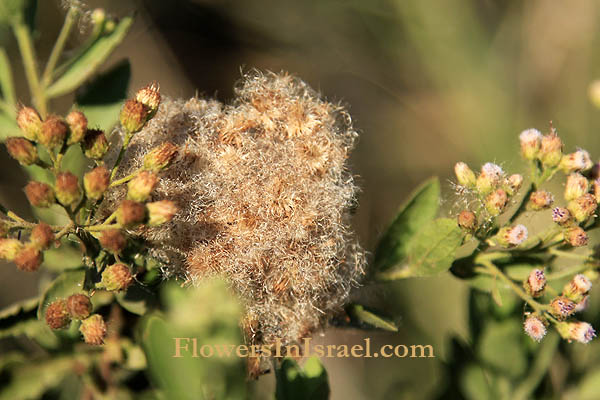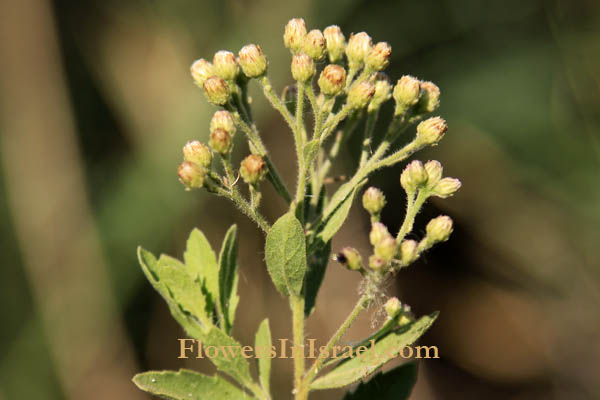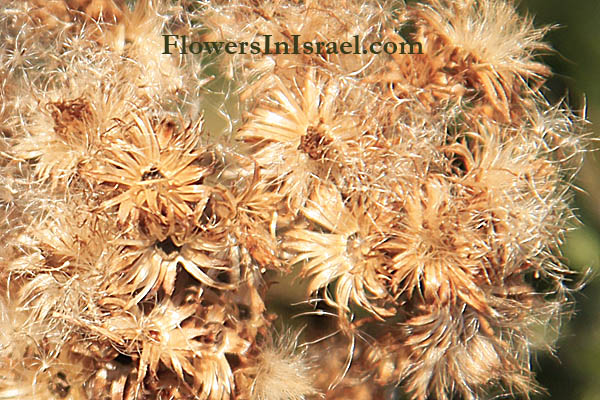Pluchea dioscoridis, Conyza dioscoridis, Baccharis dioscoridis,
Ploughmans spikenard, Marsh fleabane,
Hebrew: פלגית שיחנית, Arabic: barnûf, kûsh, فونرب, Egypt: برنوف "Barnouf"
|
|
| Scientific name: |
| Pluchea dioscoridis (L)DC. |
| Synonym name: |
| Conyza dioscoridis (L.) Desf., Baccharis dioscoridis L. |
| Common name: |
| Ploughmans spikenard, Marsh fleabane |
| German (Deutsch): |
| Dörrkraut |
| Hebrew name: |
| פלגית שיחנית |
| Arabic name: |
| barnûf, kûsh, فونرب |
| Egypt: |
| برنوف "Barnouf" |
| Family: |
| Compositae / Asteraceae, מורכבים |

Location: Golan Heights
|
|
|
| Life form: |
| Phanerophyte shrub |
| Leaves: |
| Alternate, entire, lanceolate, dentate or serrate |
| Flowers: |
| Pale yellow or pink |
| Flowering Period: |
| March, April, May, June, July, August, September |
| Habitat: |
| Humid habitats |
| Distribution: |
| Mediterranean Woodlands and Shrublands, Semi-steppe shrublands, Deserts and extreme deserts |
| Chorotype: |
| Saharo-Arabian - Sudanian |
| Summer shedding: |
| Perennating |

Location: Golan Heights
Derivation of the botanical name:
Pluchea , named after the French naturalist Noel Antoine Pluche (1688-1761),
dioscoridis, named in honor of the first century Greek physician and herbalist Dioscoridis.
The Hebrew name: פלגית, palgit, conyza.
- The standard author abbreviation L. is used to indicate Carl Linnaeus (1707 – 1778), a Swedish botanist, physician, and zoologist, the father of modern taxonomy.
- The standard author abbreviation DC. is used to indicate Augustin Pyramus de Candolle (1778 – 1841), a Swiss botanist.
- The standard author abbreviation Desf. is used to indicate René Louiche Desfontaines (1750 – 1833), a French botanist.[
Pluchea dioscoridis has a good reputation in folk medicine, it is used in popular medicine for rheumatic pains. It is reported that the decoction of fresh leaves is use in the treatment of epilepsy in children, in colic, as carminative and as remedy for cold. The aromatic leaves of the plant which have a pleasant scent were used in Ancient Egypt to perfume ladies’ hair plaits. In Tanzania, the plant is used by traditional healers as: a decoction of root bark and cooking fat (a few drops) drunk against sterility in women and impotence in men, a decoction of the root to treat colds, the roots and leaves are a stimulant, comforting medicine and an aromatic and the decoction of the leaves is used for curing children and infantile ailments.

Location: Golan Heights
|


